Paintings within Paintings
An Informal Correspondence between Mary Flinn and Eleanor Rufty
“Paintings within Paintings” completes a suite about Eleanor Rufty's work begun in Blackbird 20n1. This previous content is linked from the footer menu and contributor’s notes page.
Rooms carry considerable formal and symbolic weight when they are represented in paintings, as do the images that might appear in these rooms. Sometimes they seem to act as stand-ins for the artist’s mind or as commentary for the connections being explored in the full work. Eleanor Rufty states that she is not pursuing explicit representation in her work, but calls her figures and their settings from memory and imagination.
Perusing her work, a viewer notices that there are instances where images of paintings or drawings on the walls in these pieces seem to serve very intentional purposes, both for the composition of the piece and for its emotional—and visual—resonance.
Rufty’s Studio Wall Series from the mid 1990s contains the first group of pieces employing drawings within drawings or paintings within paintings. These works on paper declare themselves to be self-portraits and name the content of the images that appear in parallel panels to those that contain self-portraits.
~
Mary Flinn: Could you please comment on how you chose these compositions? Why self-portraits? Why self-portraits with specifically named artistic companions? What problems were you trying to explore or solve?
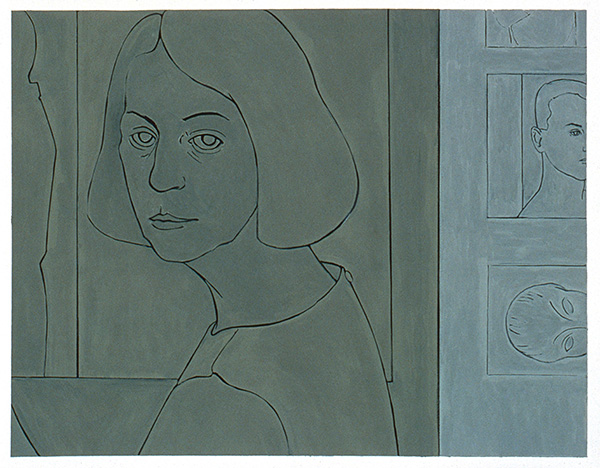 |
| Eleanor Rufty Studio Walls Series: Self-Portrait with Jason and Sleeping Muse 1995 gouache 22 x 30 inches |
Eleanor Rufty: In my studio, one large wall is set up for drawing—a padded area covered in canvas where I attach large sheets of paper. Along the side of this area is a strip of blank wall where for years I have tacked up small photos, postcards, mementos. The images have changed over time although some have been there for decades.
I have always found artists’ self-portraits very interesting to observe and also to do. I had made some previous efforts that were mainly studies of the head. The Studio Wall Series began as a painting of myself in the studio. I had a small mirror set up that I could glance into as needed. There were unfinished drawings on the wall. I intended to use fragments of these as background. To my left was that strip of postcards and photos. As I was working I began to see ways I could use these images in my picture.
In the first painting, Jason and Sleeping Muse, I included two items: a photo of my son Jason, hair slicked back from swimming, next to a reproduction of a Brancusi sculpture because I thought the two heads seemed similar. So now there were three figures and the self-portrait became a part of a larger scene, possibly suggesting a kind of narrative. In the second piece, Laura and the Three Spirits
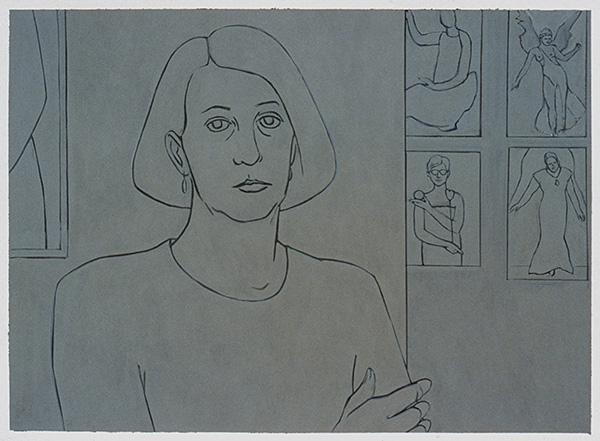 |
| Eleanor Rufty Laura and the Three Spirits 1995 gouache 22 x 30 inches |
I arranged the postcards around a theme of movement and performing. Laura is a dancer/choreographer for whom I have designed costumes. The spirits are a drawing of Isadora Duncan by Rodin, a photo of Bessie Smith, and a reproduction of a Nike figure in the Louvre.
The next four paintings that completed the series were developed in a similar way, each set of images having a connection to each other or to the artist or both. The titles are important—and I named certain figures in the way of a dedication.
The panels in the paintings suggest the two sections of the wall in my studio and also a color or tonal change. I worked in a limited palette of grays.
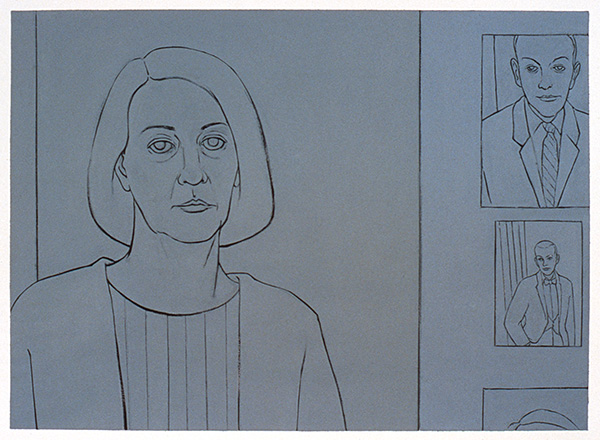 |
| Eleanor Rufty Studio Wall Series: Self-Portrait with Two Freds (Second Version) 1997 gouache 22 x 30 inches |
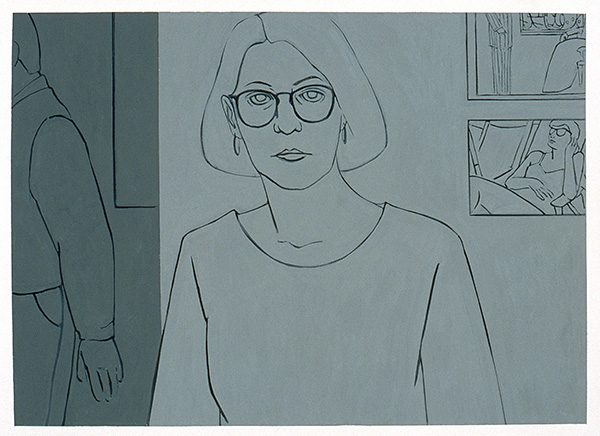 |
| Eleanor Rufty Studio Wall Series: Self-Portrait with Woman on the Beach 1995 gouache 22 x 30 inches |
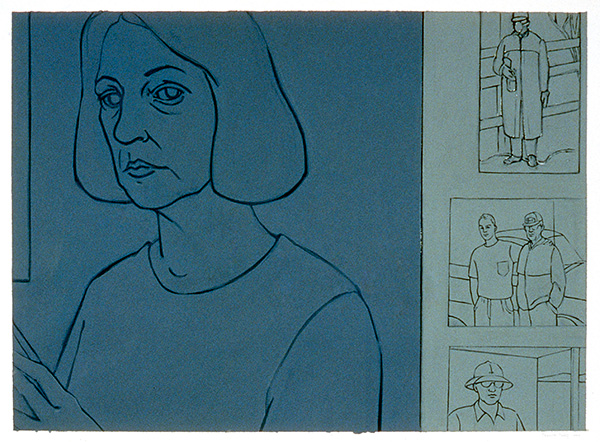 |
| Eleanor Rufty Studio Wall Series: Self-Portrait (to Harold) 1997 acrylic 22 x 30 inches |
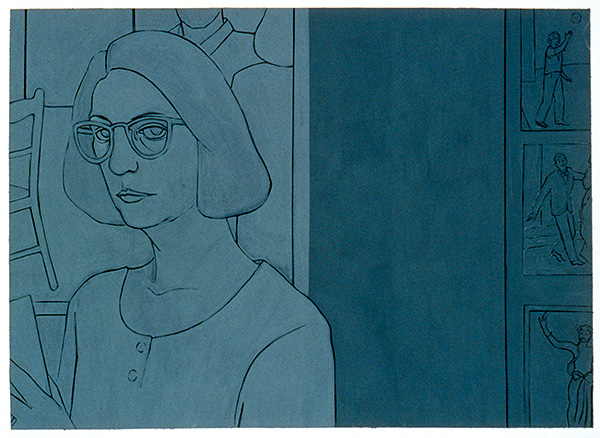 |
| Eleanor Rufty Studio Wall Series: Self-Portrait (to Jean) 1995 acrylic 22 x 30 inches |
I never think in terms of problem solving in the making of art, unless it applies to something technical. I know many artists use this term, but I never have. I am an intuitive painter. The concept comes to me during the process, but not beforehand. I am never really sure of why I make something.
MF: After the Studio Wall Series, you seem to have replaced the wall images with much more complex rooms with windows that look out at other figures beyond the rooms. And the rooms are much more spatially complex. Yet the windows seem to serve much the same purpose as the wall’s drawings—providing a psychological commentary or serving as windows into memory.
What changed your perception, so to speak? What was the impetus to open the painting’s field to exterior views that (being often of a beach) seem to extend into a very distant horizon?
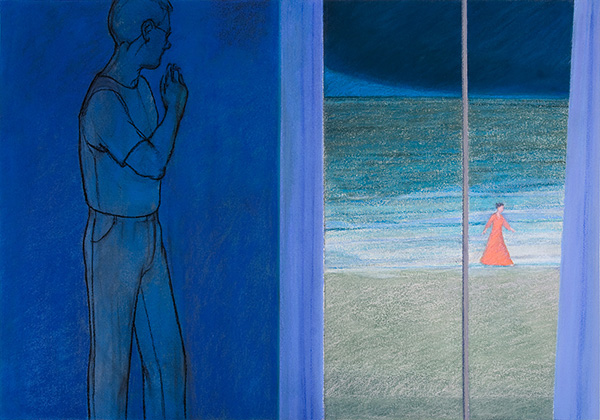 |
| Eleanor Rufty The Beach Pictures: . . . on the verge of a scene. 2008 pastel on tinted watercolor paper 29.5 x 41 inches |
ER: There is a period of thirteen years between the Studio Wall Series and The Beach Pictures. My work had gone through several changes during this time. In 1998, I began a series of figurative oil paintings that were shown in 2003, and after that I returned to large scale charcoal drawings, exhibited in 2006. The window form, simple and opaque, was a compositional element in some of these paintings and the “picture within a picture” was an element in several of the charcoals, but neither were compelling issues at the time.
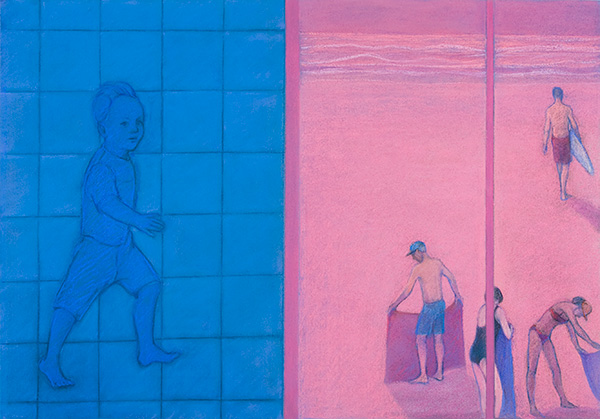 |
Eleanor Rufty |
To me, The Beach Pictures are elegiac, a visual memorial to a place and period of time, a place we as a family have visited almost every summer. My husband, the artist Richard Carlyon, had died in 2006. In the late spring of 2007, Jason and I placed his ashes in the sea there, at a spot he had pointed out to Jason years before. I began the series in 2008.
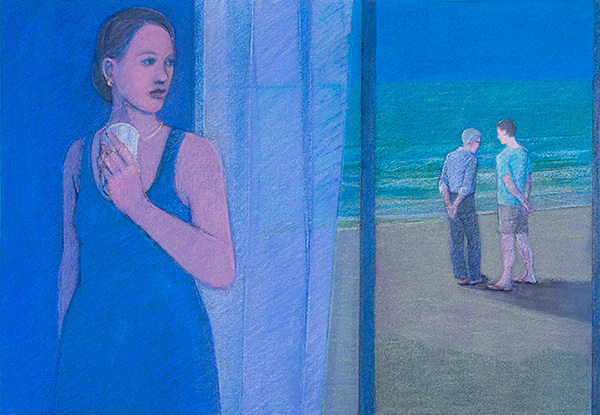 |
| Eleanor Rufty The Beach Pictures: . . . when the shadow of a cloud . . . 2007 pastel on tinted watercolor paper 29.5 x 41 inches |
This group of large-scale pastels was completed in a little over a year. Initially, I did not plan to do so many, but my mind was full of memories of our trips to the beach. I began the first piece drawing a woman at a window looking out on a beach. I always start to work with free gestural marks. When I sketched two figures on the beach outside, one of them was so suggestive of Richard’s gesture and stance that I thought—OK, it will be Richard on the beach. The final image became a conversation between Richard and Jason on the beach. With this drawing the theme was set, one work led to the next and finally ten. This is typical of my artistic process.
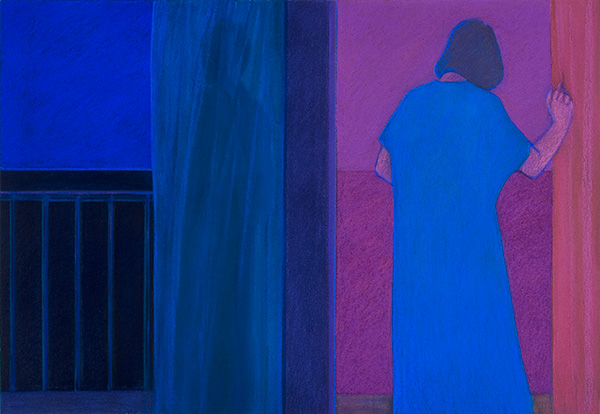 |
Eleanor Rufty |
Each work is based on a moment, a fragment of an actual event. Pictorially, the spaces represent the beach or the ocean, sometimes viewed from an interior through a window or balcony door. Two areas sometimes are divided by contrasting color differences, one side may suggest a real happening, the other a memory or a dream.
In this series, I returned to the medium of pastel after a hiatus at least ten years. I greatly expanded my use of the medium technically in this series. Pastel is a difficult medium for sustained work. It can be easily over worked and deadened. I found ways to make frequent changes without losing the richness of surface or the intensity of the color that made the process and the result more like painting than drawing.
MF: The two paintings that I find significantly mesmerizing are The Music Lesson from 2016, and The Blue Studio from 2019–20. The Music Lesson certainly seems to echo Henri Matisse’s painting The Piano Lesson from 1916. What drew you to Matisse’s composition?
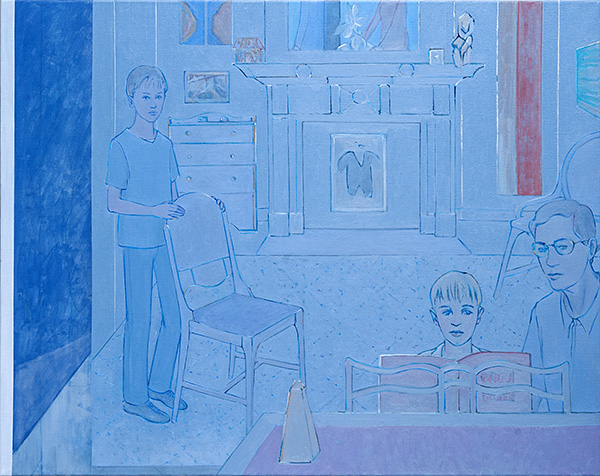 |
| Eleanor Rufty The Music Lesson 2016 oil and wax medium on canvas 38 x 48 inches Photo Terry Brown |
ER: Two things occurred in 2016 that led to The Music Lesson. I moved my late mother’s piano, that had been in our family since the late 1940s, into my home and my grandson Miles began to take lessons. I watched him, as he practiced, with the thought a making a painting.
Of course, I was inspired by Matisse’s great painting, The Piano Lesson. I saw Miles at the piano—as Pierre had been, pictured in a more abstract way. I also love the image of the teacher sitting very straight on a stool. An early Carlyon sculpture that sits on the mantel in the same room as the piano reminds me of that figure. I used the detail of that sculpture in my painting as a small tribute.
I had never used a specific room in my paintings or thought about my living space as a possible subject. But the presence of the piano, the scene of the music lessons in my front room, made the choice seem inevitable. In my painting, The Music Lesson, the room is not a literal interpretation. I have taken many liberties. I “erased” the wall where the piano sits to open the entire space so the student and teacher can be seen. The space and the objects in the room, including the art on the walls, are subtly recognizable and the color of things is accurate, but tempered by an overall ground of blue and blue gray.
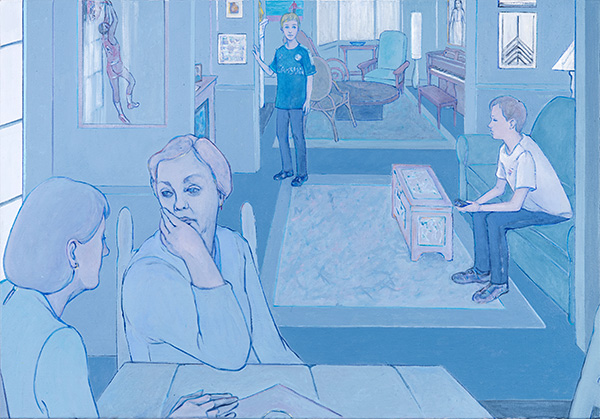 |
| Eleanor Rufty Jean’s Piano 2017–18 oil and wax medium on canvas 25 x 36 inches Photo by Terry Brown |
I made a second painting, Jean’s Piano, that depicts a long view through three rooms in my house. In this painting, the figures sit or stand in the rooms and also are visible on the walls in various art works. The palette is similar—subtle colors in a blue-gray ground.
MF:What seems clear in these two paintings and in The Blue Studio is how the familiar space and beloved people in these pieces are critical to your artistic purpose. The Blue Studio almost seems to me like an ars poetica, an encapsulation of your artistic drive and purpose and desire.
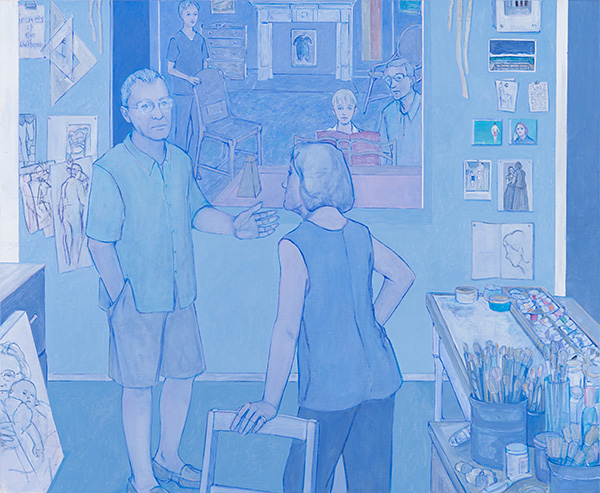 |
| Eleanor Rufty The Blue Studio (to W. G.) 2019–2020 oil and wax medium on canvas 38 x 46 inches Photo Terry Brown |
ER: The Blue Studio, was based on a visit that writer and art critic, Wesley Gibson, made to my studio while I was painting The Music Lesson. Wesley was a close friend and would come by the studio whenever he was in town. I looked forward to any observation he might make. On this day, his comments were especially meaningful. This painting was a change of direction, and I was in some doubt about how it was going and how far to take it. He was positive, enthusiastic, and encouraging, so when I finished the painting a few months later, I took a snapshot of it and sent an email to him in San Francisco. I never received a reply. A short time later I received the very sad news that Wesley had died. The Blue Studio reflects on that moment in the studio and is a tribute to a remarkable writer who was my friend.
I found painting this space while inside it, so to speak, a little strange, even uncanny. I painted a copy of The Music Lesson as it appeared unfinished and as if it were on the very wall where my current canvas was hanging. I painted the paints and brushes, the materials that I was also using at the time—the discarded tape on the wall, sketches, photos, and small paintings that were in my sight. I painted some remnants of abandoned work—a sketch of my dad in his garden, a reproduction of a Degas chair that I used in a pastel, a tiny painting of Jason with a surf board made for a Small Works exhibition, a photo of me before a mirror—visual things that surround the artist at work. And, finally, I painted myself listening to someone speak about my painting. The Blue Studio seems to be a painting about the making of a painting.
The title is a small bow to the great Matisse.
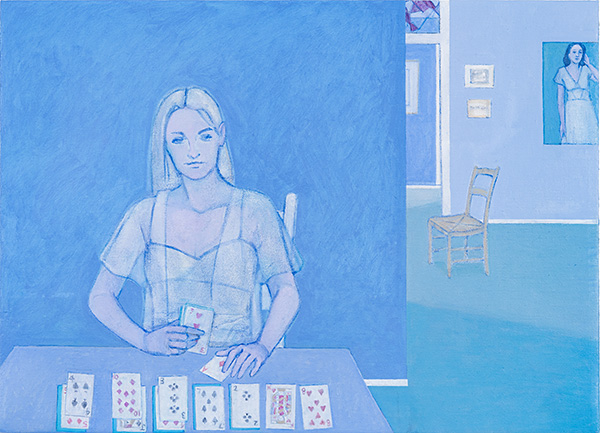 |
| Eleanor Rufty Solitaire 2020 oil and wax medium on canvas 18 x 25 inches Photo by Terry Brown |
MF: Thank you so much for taking the time to explore your work with Blackbird, and I can only say that if these are the rooms of your mind and imagination, we are so grateful to you for letting us visit. Is there anything you would like to add about these art-filled rooms in your work?
ER: The only thing I would add to your last question is that, lucky for me, I live in art-filled rooms. ![]()
Contributor’s Notes: Eleanor Rufty
New and Selected Work (related content, v20n1)